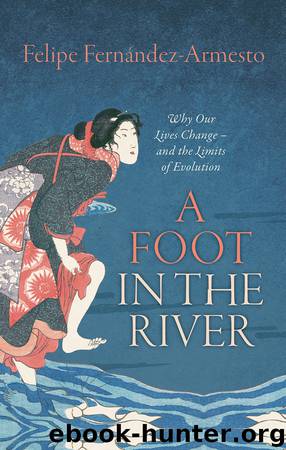A Foot in the River by Fernández-Armesto Felipe;

Author:Fernández-Armesto, Felipe;
Language: eng
Format: epub
Publisher: Oxford University Press
Published: 2015-07-17T00:00:00+00:00
* * *
The next few pages cover the merits and defects of how academics currently attempt to apply evolutionary explanations to cultural change. Apart from memetics, which we can set aside as valueless (above, pp. 90–3), and other approaches we have already dealt with (above, pp. 87–93, 138–40), the theories belong, for convenience, under seven headings: genetic determinism; cultural selection; evolutionary game theory; environmental determinism; evolutionary psychology; ‘Big History’; and ‘dual inheritance theory’ or ‘gene-culture co-evolution’. As we go through them one by one, we shall see that they are all of some help, or at least of some potential help, in explaining the origins of culture, or universal features of culture, or of some, particular changes; but they do not provide adequate explanations, even in combination, of how and why cultures change, or adequate descriptions of the range and reach of cultural divergence.
It is fair to point out, nonetheless, that theoretically dodgy assumptions do not necessarily invalidate work based on those assumptions. Some enormously valuable empirical data from archaeological projects all over the world have emerged from work done on the assumption that cultures or even particular cultural behaviours descend from one another like species—in the appropriate jargon, they are ‘phylogenetic’ or ‘hierarchically related by descent’. I do not think the assumption is valid; the professional consensus favours it only when applied to languages (which most people do regard, perhaps misleadingly, as emerging from one another like branches from trees and twigs from branches); and even some of the most distinguished upholders of evolutionary archaeology are candid in admitting that tree-like diagrams give only a very approximate and imperfect notion of the relationships between their findings. 10
Among evolutionist versions of cultural change, the first and most basic theory is simple: genes determine culture. As we have seen (above, pp. 77–90) this is an unpromising proposition. A conspicuous fact makes it inherently improbable: though humans have incomparably the widest range of cultures among primates, we also have perceptibly the tiniest range of variation in DNA. 11 That does not mean that genes have no power to help mould culture. There are cases of genetic or, in some sense, biological differences that correspond with different cultures, though it is hard to say what the balance is between the results of environmentally induced selection, such as, presumably, influences resistance to malaria in sub-Saharan African populations, or of constraints that arise from cultural bias, such as those that favour lactose tolerance in dairying cultures. 12
Some evidence has accumulated in data of the origins of sex roles. 13 Similar proportions of younger brothers tend to be gay, for instance, in different cultural environments; no one knows why, but the presumption is worth considering that women who have successive male babies may develop a hormonal response that conditions their offspring. Left-handed men are also significantly more likely to be gay than their right-handed counterparts. Work on this subject is vulnerable to bias, as the arguments in favour of the proposition that homosexuality is inborn, rather
Download
This site does not store any files on its server. We only index and link to content provided by other sites. Please contact the content providers to delete copyright contents if any and email us, we'll remove relevant links or contents immediately.
| Anthropology | Archaeology |
| Philosophy | Politics & Government |
| Social Sciences | Sociology |
| Women's Studies |
Cecilia; Or, Memoirs of an Heiress — Volume 1 by Fanny Burney(32029)
Cecilia; Or, Memoirs of an Heiress — Volume 3 by Fanny Burney(31441)
Cecilia; Or, Memoirs of an Heiress — Volume 2 by Fanny Burney(31389)
The Great Music City by Andrea Baker(30761)
We're Going to Need More Wine by Gabrielle Union(18611)
All the Missing Girls by Megan Miranda(14634)
Pimp by Iceberg Slim(13757)
Bombshells: Glamour Girls of a Lifetime by Sullivan Steve(13670)
Fifty Shades Freed by E L James(12892)
Talking to Strangers by Malcolm Gladwell(12836)
Norse Mythology by Gaiman Neil(12795)
For the Love of Europe by Rick Steves(11342)
Crazy Rich Asians by Kevin Kwan(8867)
Mindhunter: Inside the FBI's Elite Serial Crime Unit by John E. Douglas & Mark Olshaker(8673)
The Lost Art of Listening by Michael P. Nichols(7141)
Enlightenment Now: The Case for Reason, Science, Humanism, and Progress by Steven Pinker(6857)
The Four Agreements by Don Miguel Ruiz(6293)
Bad Blood by John Carreyrou(6260)
Weapons of Math Destruction by Cathy O'Neil(5805)
